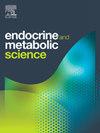Influence of metabolic syndrome in the occurrence of hearing disorders in the Democratic Republic of Congo
Q3 Medicine
引用次数: 0
Abstract
Background
The assessment of hearing function in human life is important, because good hearing is important for social participation and inclusion in employment and education. The objective of this study is to evaluate the influence of metabolic syndrome in the occurrence of hearing disorders in patients followed in hospitals in Kinshasa.
Methods
This was an analytical cross-sectional study that included 400 patients consulted in 7 hospitals in the city province of Kinshasa during the period from January 2005 to September 2020. Sociodemographic, clinical, and biological data were analyzed. Multivariate logistic regression analysis and discriminant analysis were used as a basis to document the factors associated with hearing disorders in the study population; and the statistical significance threshold was p < 5 %.
Results
The frequency of hearing loss was 40.1 % in patients with metabolic syndrome. Risk factors identified for the occurrence of hearing loss in patients with metabolic syndrome were age ≥ 60 years (aOR: 2.73 95 % CI: 1.37–5.42), waist circumference > 85 cm (Female) or > 94 cm (Male) (aOR: 2.65 95 % CI: 1.37–3.72); blood glucose ≥126 mg/dL (aOR: 2.86 95 % CI: 1.32–6.17), BMI ≥25 kg/m2 (aOR: 2.73 95 % CI: 1.89–3.32) and in patients with insulinemia >10 IU/L (aOR: 3.37 95 % CI: 1.47–7.76).
Conclusion
The frequency of hearing loss is high in the population studied. The components of the metabolic syndrome were identified as independent determinants of hearing loss.
代谢综合征对刚果民主共和国听力障碍发生的影响
人类生活中听力功能的评估是很重要的,因为良好的听力对社会参与和就业和教育都很重要。本研究的目的是评估代谢综合征对金沙萨医院随访患者听力障碍发生的影响。方法这是一项分析性横断面研究,包括2005年1月至2020年9月期间在金沙萨市省7家医院就诊的400名患者。分析了社会人口学、临床和生物学数据。采用多变量logistic回归分析和判别分析作为基础,记录研究人群中与听力障碍相关的因素;统计学显著性阈值为p <;5%。结果代谢综合征患者听力损失发生率为40.1%。代谢综合征患者发生听力损失的危险因素为年龄≥60岁(aOR: 2.73 95% CI: 1.37 ~ 5.42)、腰围和gt;85厘米(女)或>;94 cm(男性)(aOR: 2.65 95% CI: 1.37 ~ 3.72);血糖≥126 mg/dL (aOR: 2.86 95% CI: 1.32-6.17), BMI≥25 kg/m2 (aOR: 2.73 95% CI: 1.89-3.32),胰岛素血症患者≥10 IU/L (aOR: 3.37 95% CI: 1.47-7.76)。结论研究人群听力损失发生率较高。代谢综合征的组成部分被确定为听力损失的独立决定因素。
本文章由计算机程序翻译,如有差异,请以英文原文为准。
求助全文
约1分钟内获得全文
求助全文
来源期刊

Endocrine and Metabolic Science
Medicine-Endocrinology, Diabetes and Metabolism
CiteScore
2.80
自引率
0.00%
发文量
4
审稿时长
84 days
 求助内容:
求助内容: 应助结果提醒方式:
应助结果提醒方式:


